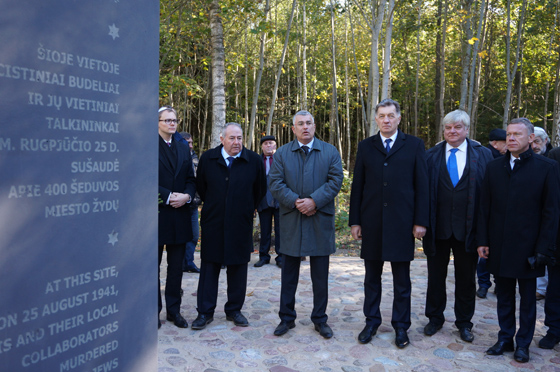Lithuanian prime minister Algirdas Butkevičius, representatives of the Lithuanian Ministry of Foreign Affairs, foreign ambassadors to Lithuania, Radviliškis regional administration representatives and Jews from all over the world as well as local residents attended a ceremony to commemorate the murdered Jews of Šeduva, Lithuania, and a ceremony to kick off the Lost Shtetl Šeduva Jewish memorial project.
They visited the restored Jewish cemetery and three mass murder sites as well as attending the ceremony for the unveiling of a monument to the Jews of Šeduva in the town center. Under private initiatives architectural compositions by the sculptor Romuoldas Kvintas now greet visitors to two mass murder sites in the Liaudiškiai forest and one in the Pakuteniai forest.
Kaddish was said at all the mass murder sites and Sergey Kanovich, the founder of the Lost Shtetl memorial fund, spoke at each memorial site about the tragic fate of the Jews of Šeduva and his project’s efforts to keep their memories alive. Children of Holocaust survivors spoke at the ceremony to unveil the monument in the town center about their parents’ efforts to survive. Some managed to flee to other countries, others found safe haven with local residents. Pinchos Nol, the last Jew born in Šeduva, came with his son to the ceremony and spoke passionately.
Lithuanian president Dalia Grybauskaitė sent a message for the opening ceremony and thanked the people behind the Lost Shtetl project. “I am glad there are always new initiatives to preserve our shared past. The Šeduva Jewish Memorial Fund project Lost Shtetl contributes significantly to the preservation of the cultural heritage of the Jews who lived in Lithuania and to educating society, honoring the memory of Jews who lived in Lithuania, and to mutual Lithuanian-Jewish dialogue,” she said in her message.
“Very many Jews lived in Šeduva, but sadly they’re all gone now. This is one of the most painful chapters in the history of humanity. There were 200 sites in Lithuania where large Jewish communities lived. Now we have 200 sites where there are mass graves of Jews shot during World War II. I hope for the younger generation to remember history, and the history of the Litvaks is a big part of the historical heritage of Lithuania,” Lithuanian Jewish Community chairwoman Faina Kukliansky said.
Prime minister Butkevičius said Šeduva is an example for other Lithuanian cities and towns to follow. Amir Maimon, Israel’s first ambassador to Lithuania; Darius Degutis, Lithuania’s former ambassador to Israel and Mantvydas Bekešius, deputy Lithuanian foreign minister, attended the ceremony as well.
Sergey Kanovich, founder of the Šeduva Jewish Memorial Fund and initiator of the Lost Shtetl project, said seventy years of forgetting hides the tragedy of the Jewish people. “When we removed the top layer accumulated over seventy years from the Šeduva Jewish cemetery, we uncovered much more history than we expected,” he commented.
Radviliškis regional administration head Antanas Čepononis presented Edvinas Glasenberg, the brother and representative of the main financial supporter of the Šeduva Jewish memorial Fund Ivan Glasenberg, an official letter of commendation for elucidating the history of Šeduva, commemorating the former Jewish residents, for contributing to the preservation of the historical heritage of the Radviliškis and for supporting the Šeduva area.
Information provided by the Radviliškis regional administration


